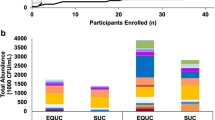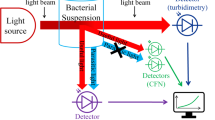Abstract
The workup and interpretation of urine cultures is not always clear-cut, especially for midstream samples contaminated with commensals. Standard urine culture (SUC) protocols are designed in favor of growth of uropathogens at the expense of commensals. In selected clinical situations, however, it is essential to trace fastidious or new uropathogens by expanding the urine culture conditions (EUC). The aim of our study was to map the microflora in midstream urine specimens from healthy controls by means of EUC, in view of the interpretation of bacterial culture results in symptomatic patients. Midstream urine specimens from 101 healthy controls (86 females and 15 males) were examined using both SUC and EUC. Whilst 73 % of samples examined by SUC showed no growth at 103 colony-forming units (CFU)/mL, 91 % of samples examined by EUC grew bacterial species in large numbers (≥104 CFU/mL). Asymptomatic bacteriuria, as defined by the European guidelines for urinalysis, was detected in six samples with both protocols. EUC revealed 98 different species, mostly Lactobacillus, Staphylococcus, Streptococcus, and Corynebacterium. None of the samples grew Staphylococcus saprophyticus, Corynebacterium urealyticum, or Aerococcus urinae. Samples from females contained higher bacterial loads and showed higher bacterial diversity compared to males. Midstream urine of healthy controls contains large communities of living bacteria that comprise a resident microflora, only revealed by EUC. Hence, the use of EUC instead of SUC in a routine setting would result in more sensitive but less specific results, requiring critical interpretation. In our view, EUC should be reserved for limited indications.



Similar content being viewed by others
References
Wilson ML, Gaido L (2004) Laboratory diagnosis of urinary tract infections in adult patients. Clin Infect Dis 38(8):1150–1158
Garcia LS (2010) Clinical microbiology procedures handbook, 3rd edn. ASM Press, Washington DC, pp 410–440
McCarter YS, Burd EM, Hall GS, Zervos M (2009) Cumitech 2C: laboratory diagnosis of urinary tract infections (Cumitechs). ASM Press, Washington DC
Aspevall O, Hallander H, Gant V, Kouri T (2001) European guidelines for urinalysis: a collaborative document produced by European clinical microbiologists and clinical chemists under ECLM in collaboration with ESCMID. Clin Microbiol Infect 7(4):173–178
Brown MK, Forbes BA, Stitley K, Doern CD (2016) Defining the clinical significance of Alloscardovia omnincolens in the urinary tract. J Clin Microbiol 54(6):1552–1556
Fouts DE, Pieper R, Szpakowski S, Pohl H, Knoblach S, Suh MJ, Huang ST, Ljungberg I, Sprague BM, Lucas SK, Torralba M, Nelson KE, Groah SL (2012) Integrated next-generation sequencing of 16S rDNA and metaproteomics differentiate the healthy urine microbiome from asymptomatic bacteriuria in neuropathic bladder associated with spinal cord injury. J Transl Med 10:174
Lewis DA, Brown R, Williams J, White P, Jacobson SK, Marchesi JR, Drake MJ (2013) The human urinary microbiome; bacterial DNA in voided urine of asymptomatic adults. Front Cell Infect Microbiol 3:41
Siddiqui H, Nederbragt AJ, Lagesen K, Jeansson SL, Jakobsen KS (2011) Assessing diversity of the female urine microbiota by high throughput sequencing of 16S rDNA amplicons. BMC Microbiol 11:244
Wolfe AJ, Toh E, Shibata N, Rong R, Kenton K, Fitzgerald M, Mueller ER, Schreckenberger P, Dong Q, Nelson DE, Brubaker L (2012) Evidence of uncultivated bacteria in the adult female bladder. J Clin Microbiol 50(4):1376–1383
Dong Q, Nelson DE, Toh E, Diao L, Gao X, Fortenberry JD, Van der Pol B (2011) The microbial communities in male first catch urine are highly similar to those in paired urethral swab specimens. PLoS One 6(5):e19709
Pearce MM, Hilt EE, Rosenfeld AB, Zilliox MJ, Thomas-White K, Fok C, Kliethermes S, Schreckenberger PC, Brubaker L, Gai X, Wolfe AJ (2014) The female urinary microbiome: a comparison of women with and without urgency urinary incontinence. MBio 5(4):e01283-14
Nienhouse V, Gao X, Dong Q, Nelson DE, Toh E, McKinley K, Schreckenberger P, Shibata N, Fok CS, Mueller ER, Brubaker L, Wolfe AJ, Radek KA (2014) Interplay between bladder microbiota and urinary antimicrobial peptides: mechanisms for human urinary tract infection risk and symptom severity. PLoS One 9(12):e114185
Khasriya R, Sathiananthamoorthy S, Ismail S, Kelsey M, Wilson M, Rohn JL, Malone-Lee J (2013) Spectrum of bacterial colonization associated with urothelial cells from patients with chronic lower urinary tract symptoms. J Clin Microbiol 51(7):2054–2062
Hilt EE, McKinley K, Pearce MM, Rosenfeld AB, Zilliox MJ, Mueller ER, Brubaker L, Gai X, Wolfe AJ, Schreckenberger PC (2014) Urine is not sterile: use of enhanced urine culture techniques to detect resident bacterial flora in the adult female bladder. J Clin Microbiol 52(3):871–876
Price TK, Dune T, Hilt EE, Thomas-White KJ, Kliethermes S, Brincat C, Brubaker L, Wolfe AJ, Mueller ER, Schreckenberger PC (2016) The clinical urine culture: enhanced techniques improve detection of clinically relevant microorganisms. J Clin Microbiol 54(5):1216–1222
Kass EH (1962) Pyelonephritis and bacteriuria. A major problem in preventive medicine. Ann Intern Med 56:46–53
Franz M, Hörl WH (1999) Common errors in diagnosis and management of urinary tract infection. I: pathophysiology and diagnostic techniques. Nephrol Dial Transplant 14(11):2746–2753
Nelson DE, Van Der Pol B, Dong Q, Revanna KV, Fan B, Easwaran S, Sodergren E, Weinstock GM, Diao L, Fortenberry JD (2010) Characteristic male urine microbiomes associate with asymptomatic sexually transmitted infection. PLoS One 5(11):e14116
Acknowledgments
The authors would like to thank the healthy volunteers for their cooperation and the technicians of the Department of Laboratory Medicine for their technical contributions.
Author information
Authors and Affiliations
Corresponding author
Ethics declarations
Funding
No funding was received.
Conflict of interest
The authors have no conflict of interest.
Ethical approval
The study was approved by the Ethical Committee of the Ghent University Hospital with Belgian registration number B670201525210.
Informed consent
All included healthy volunteers gave written informed consent.
Rights and permissions
About this article
Cite this article
Coorevits, L., Heytens, S., Boelens, J. et al. The resident microflora of voided midstream urine of healthy controls: standard versus expanded urine culture protocols. Eur J Clin Microbiol Infect Dis 36, 635–639 (2017). https://doi.org/10.1007/s10096-016-2839-x
Received:
Accepted:
Published:
Issue Date:
DOI: https://doi.org/10.1007/s10096-016-2839-x




